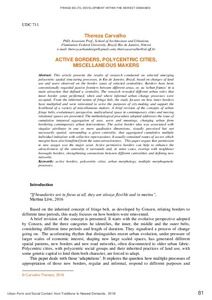Показать сокращенную информацию
ACTIVE BORDERS, POLYCENTRIC CITIES, MISCELLANEOUS MAKERS
| Автор | Carvalho, Thereza | |
| Дата внесения | 2019-07-10T08:03:41Z | |
| Дата, когда ресурс стал доступен | 2019-07-10T08:03:41Z | |
| Дата публикации | 2019-05 | |
| ISBN | 978-5-7638-4127-5 | |
| URI (для ссылок/цитирований) | https://elib.sfu-kras.ru/handle/2311/111679 | |
| Описание | Proceedings of the XXV ISUF International Conference “Urban Form and Social Context: from Traditions to Newest Demands” (Krasnoyarsk, July 5–9, 2018) | ru_RU |
| Аннотация | This article presents the results of research conducted on selected emerging polycentric spa-tial structuring processes, in Rio de Janeiro, Brazil, based on changes of land use and users observed on the border zones of selected centralities. Borders have been conventionally regarded passive fron-tiers between different areas, or, as ‘urban frames’ to a main attraction that defined a centrality. The research revealed different urban roles that inner border zones performed, when and where informal urban change processes were accepted. From the inherited notion of fringe belt, the study focuses on how inner borders have multi-plied and were reinvented to serve the purposes of city-making and support the livelihood of a variety of miscellaneous makers. A brief revision of the concepts of urban fringe belts, evolutionary perspec-tive, multicultural space in contemporary cities and moving relational spaces are presented. The meth-odological procedure adopted addresses the issue of cumulative temporal aggregation of uses, users and meanings, changing urban form bordering contemporary urban interventions. The active border idea was associated with singular attributes in one or more qualitative dimensions, visually perceived but not necessarily spatial, surrounding a given centrality, that aggregated cumulative multiple indi-vidual initiatives with collective repercussions. It usually contained routes of access which margins have also benefitted from the same attractiveness. This paper argues that permission to new usages was the major asset. Active permissive borders can help to enhance the attractiveness of the centrality it surrounds and, in some cases, overlap with neighbour boroughs borders, strengthening connections between different centralities and de-fining new networks. | ru_RU |
| Язык | en | ru_RU |
| Издатель | Siberian Federal University | ru_RU |
| Издатель | Сибирский федеральный университет | ru_RU |
| Тема | active borders, polycentric cities, urban morphology, multiple morphogenetic processes | ru_RU |
| Название | ACTIVE BORDERS, POLYCENTRIC CITIES, MISCELLANEOUS MAKERS | ru_RU |
| Тип | Conference Item | ru_RU |
| Тип | Conference Paper | ru_RU |
| Контакты автора | Carvalho Thereza: PhD. Associate Prof. Thereza Carvalho School of Architecture and Urbanism, Fluminense Federal University Brazil, Rio de Janeiro, Niteroi, e-mail: thereza.urbandesign@gmail.com, therezacarvalho@id.uff.br | ru_RU |
| Страницы | 81 -90 | ru_RU |
| Место издания | Красноярск | ru |
| Место издания | Krasnoyarsk | en |

